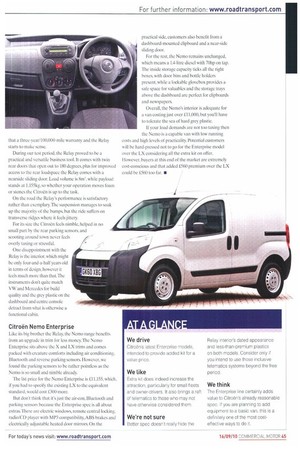udget busters
Page 44

Page 45

If you've noticed an error in this article please click here to report it so we can fix it.
Citroen is offering fleet operators and small business owners more for less with a range-topping spec called Enterprise for its entire range of vans. CM looks at the Relay and Nemo versions.
Words: Ian Tonkin
Fleet managers have to perform a delicate balancing act when it comes to purchasing new vehicles. They need to juggle vehicle cost with driver comfort, fuel efficiency, tax, and the list goes on.
Citroen believes it has a single solution to all these problems with the Relay Enterprise panel van boasting a generous amount of standard equipment that would otherwise have been optional.
For starters, there are two Relay models offered with the Enterprise package — the 30 L1H1 2.21-IDi 100 and the 35 L3H2 2.2HDi 120. In this instance, we're testing the 100hp version.
The Enterprise spec brings standard equipment such as Trafficrnaster satellite navigation, Trackstar stolen vehicle tracking, Bluetooth, air conditioning, reverse park sensors and a full steel bulkhead. However, standard doesn't necessarily mean free because there's a catch — albeit a small one.
Our Enterprise model is £900 dearer on list price at £18,440 versus the basic 100hp van, but Citroen is quick to point out that specifying all the aforementioned goodies individually on a standard van will cost more than £1,200.
But before you commit to purchase be aware that the sat-nay service and Trackstar are free only for the first three years after purchase, thereafter the owner will have to renew the subscription. Also, the Trafticmaster live traffic information facility is free for the first month, then it too becomes the owner's responsibility whether to continue with it or not.
The list price compares favourably to the equivalent £18,155 Ford Transit. Yes, the Blue Oval is marginally cheaper, but remember that Bluetooth and air-con for the Transit together cost £700 extra. And that's before you start specifying say-nay (£945) and rear parking sensors (£200).
The Relay's running costs are also acceptable, with service intervals scheduled every 25,000 miles (every 15,000 miles on Transit) and combined fuel consumption hovering around the 35mpg mark (claimed). Couple to that a three-year/100,000-mile warranty and the Relay starts to make sense.
During our test period, the Relay proved to be a practical and versatile business tool. It comes with twin rear doors that open out to 180 degrees, plus for improved access to the rear loadspacc the Relay comes with a nearside sliding door. Load volume is 8m1, while payload stands at 1,155kg, so whether your operation moves foam or stones the Citroen is up to the task.
On the road the Relay's performance is satisfactory rather than exemplary The suspension manages to soak up the majority of the bumps, but the ride suffers on transverse ridges where it feels jittery.
For its size the Citroen feels nimble, helped in no small part by the rear parking sensors, and scooting around town never feels overly taxing or stressful.
One disappointment with the Relay is the interior, which might be only four-and-a-half years old in terms of design, however it feels much more than that.The instruments don't quite match VW and Mercedes for build quality and the grey plastic on the dashboard and centre console detract from what is otherwise a functional cabin.
Citroen Nemo Enterprise
Like its big brother the Relay, the Nemo range benefits from an upgrade in trim for less money. The Nemo Enterprise sits above the X and LX trims and comes packed with creature comforts including air conditioning, Bluetooth and reverse parking sensors. However, we found the parking sensors to be rather pointless as the Nemo is so small and nimble already.
The list price for the Nemo Enterprise is .£11,155, which, if you had to specify the existing LX to the equivalent standard, would cost .000 more.
But don't think that it's just the air-con, Bluetooth and parking sensors because the Enterprise spec is all about extras. there are electric windows, remote central locking, radio/CD player with MP3 compatibility, ABS brakes and electrically adjustable heated door mirrors. On the practical side, customers also benefit from a dashboard-mounted clipboard and a near-side sliding door.
For the rest, the Nemo remains unchanged, which means a 1.4-litre diesel with 70hp on tap. The inside storage capacity ticks all the right boxes, with door bins and bottle holders present, while a lockable glovebox provides a safe space for valuables and the storage trays above the dashboard are perfect for clipboards and newspapers.
Overall, the Nemo's interior is adequate for a van costing just over £11,000, but you'll have to tolerate the sea of hard grey plastic.
If your load demands are not too taxing then the Nemo is a capable van with low running costs and high levels of practicality. Potential customers will be hard-pressed not to go for the Enterprise model over the LX considering all the extra kit on offer. However, buyers at this end of the market are extremely cost-conscious and that added £560 premium over the LX could be £560 too far. •




























































































































